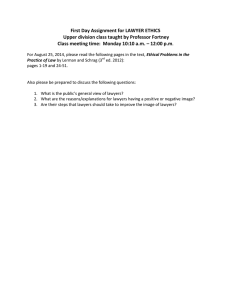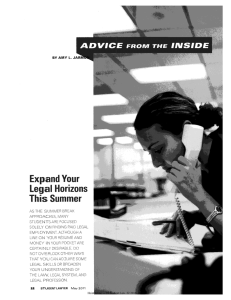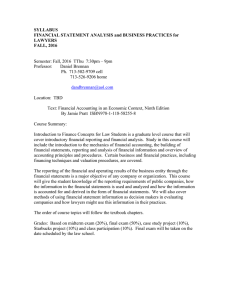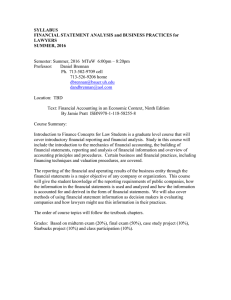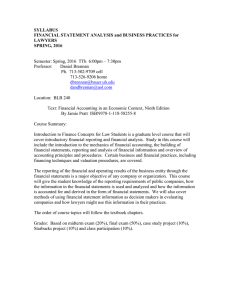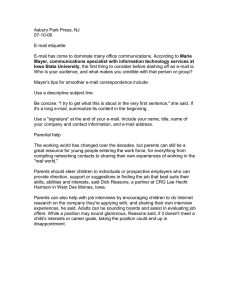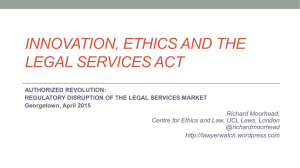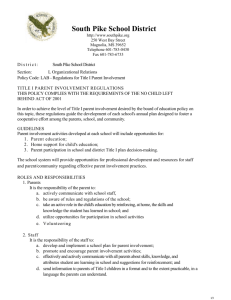+ 2 (,1 1/,1(
advertisement
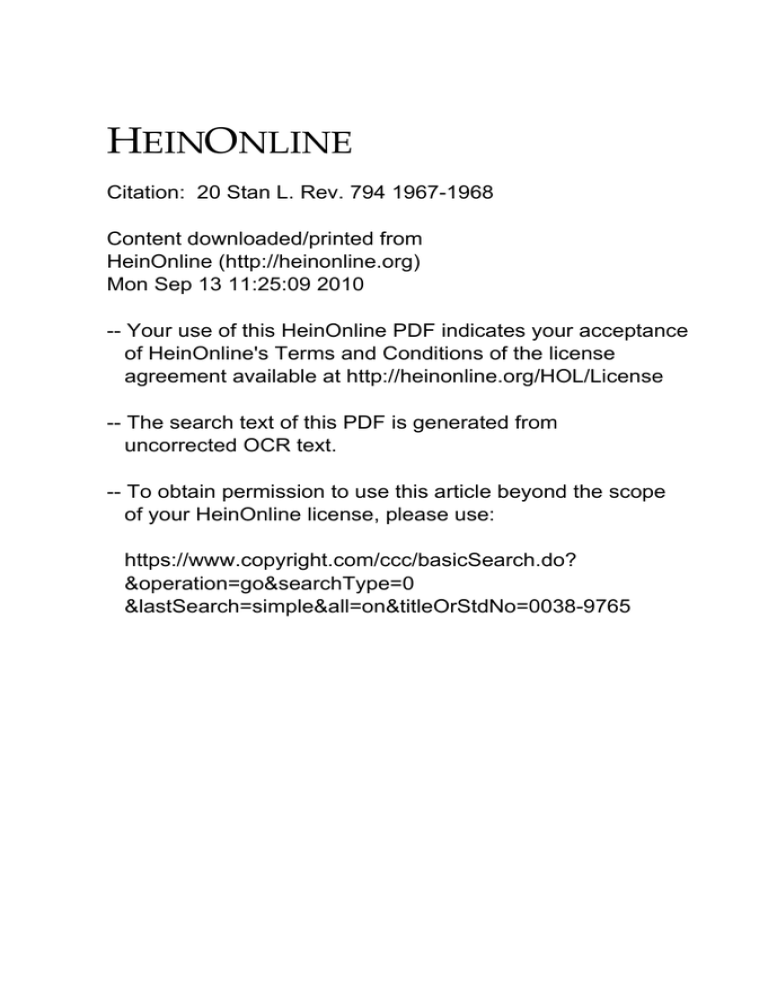
+(,121/,1( Citation: 20 Stan L. Rev. 794 1967-1968 Content downloaded/printed from HeinOnline (http://heinonline.org) Mon Sep 13 11:25:09 2010 -- Your use of this HeinOnline PDF indicates your acceptance of HeinOnline's Terms and Conditions of the license agreement available at http://heinonline.org/HOL/License -- The search text of this PDF is generated from uncorrected OCR text. -- To obtain permission to use this article beyond the scope of your HeinOnline license, please use: https://www.copyright.com/ccc/basicSearch.do? &operation=go&searchType=0 &lastSearch=simple&all=on&titleOrStdNo=0038-9765 BOOKS Reviewed AN U uRRm D VImw oF CoPYEIGHT. By Benjamin Kaplan. New York: Columbia University Press. 1967. xii + 142 pages. $5.oo. Edmund W. KitchAn Unhurried View of Copyright is a welcome addition to the field of intellectual property, a field in which the writing is all too often dominated by the simplistic theme of "we want more protection." Professor Kaplan's is an urbane and balanced view of the institution of copyright; he sees flaws as well as strengths in the institution. Professor Kaplan shows a refreshing willingness to examine every problem carefully from all sides. The book has intellectual style. The volume is made up of three James S. Carpentier Lectures given at Columbia University, Law School in 1966. The lectures were probably disappointing to the audience. Each of them is full of ideas too subtle to be caught by ear and complexities too great to be unraveled at a single hearing. Professor Kaplan does not offer grand generalities that can be remembered and taken home from the lecture like groceries from the supermarket; he teaches not by precept but by example. Those who found the lectures difficult to appreciate will find the book more rewarding. The first lecture is a brief survey of the history of copyright, in which Professor Kaplan recounts the gradual expansion of copyright from a simple device to prevent the copying of books to the expansive and diverse institution it had become by the end of the 19 th century. The process described is common in the growth of the law: extreme cases were used to formulate principles that were then widely applied. In the case of copyright the process was supported by a slowly expanding statutory base. Professor Kaplan relates the development of copyright to the shift from the classical idea of the author as a skilled craftsman working with a stock of received cultural materials to the romantic conception of the author as a neogod, fashioning art out of the raw stuff of life. The first view minimizes the author's claim to be a unique creator and is tolerant of borrowing; the second stresses the contribution of the author and regards borrowing as undesirable. The suggested correspondence is an interesting one; it brings "B.A. 196i, Yale University; J.D. x964, University of Chicago. Assistant Professor of Law, University of Chicago. The reader may enjoy comparing this review with that by Richard Wincor in 76 Ya LJ. 1473 (1967). HeinOnline -- 20 Stan L. Rev. 794 1967-1968 Apri 1968 ] BOOKS REVIEWED into the classroom discussion of copyright a debate that has cultural significance. But as a causal explanation of the expansion of copyright it is open to challenge. Battles over copyright have been fought by publishers, not authors; and economic interests, rather than literary critics, have played the chief role in its development. The second, and best, lecture deals with the copyright-law problem of how much taking constitutes infringement. In this lecture Kaplan develops the theme that there can be no unitary doctrine of protected interests in copyright. The media to which copyright extends are so diverse that in each area a court must fashion the rules of copyrightability and infringement with careful attention to the impact of any rule on the media involved. The difference between a copyright on a painting and a copyright on a bibliographical compilation should not be ignored. However, when Professor Kaplan, pursuing this analysis, comes upon the economic issues of copyright, he does so with trepidation and untypical fuzziness. Of the application of copyright to commercial designs, he writes: Copyright itself seems out of place where the artistic structure is only one of a number of elements attracting customers to the particular goods, that is, where the goods are not "fragile" in the sense in which books customarily are. What power, moreover, do we want to give to a seller by means of the copyright to threaten to block entry into a field? Think here of cases where all sellers must bring their designs within the perimeter of a seasonal fashion that sets a limit on feasible variation. Full analysis would, I think, tend to justify a copyright, if at all, only when the artistic component is primary; even then the copyright should serve to prevent only dose imitation.' Unfortunately, Professor Kaplan does not spell out the full analysis. The argument is, I think, that where the primary attractiveness of a good to customers is its commercial or industrial component, the difficulties of producing and marketing the good give the innovator a substantial advantage without copyright, and that the drawbacks of the inflexible institution of copyright, with its long time periods, are increased when an effective monopoly on more than an artistic creation is allowed The third lecture is a discussion of the issues raised by the copyrightrevision bill now being considered by Congress3 and by possible future developments resulting from changes in technology. This lecture is less effective than the other two. It is a much-needed plea for a "temperate" I. P.55. 2. Patent law, through its concept of "nonobviousness" (the concept that the invention must be such that it would not be obvious to a trained practitioner in the art), moderates between the interest in providing incentive and the interest in avoiding restrictions on competition. See Kitch, Graham v. John Deere Co.: New Standards for Patents, 1966 Sup. CT. PLv. 293, 301-03. Copyright law must somewhat less elegantly adjust between the same rival interests, largely by manipulating the doctrine of what constitutes appropriation sufficient to be infringement and by limiting the types of work eligible for copyright protection. 3. H.R. 2512, goth Cong., ISt Sess. (1967). HeinOnline -- 20 Stan L. Rev. 795 1967-1968 STANFORD LAW REVIEW [Vol. 2o: Page 794 approach to the problems of revision. Unfortunately, Professor Kaplan's clear distaste for the intemperate and self-interested arguments swirling around the present revision bill deprive his comments of force, and I fear that his perceptive but carefully qualified position will have little impact on the legislative outcome. Guiding the courts, not Congress, is his metier. On the issue of the revision bill's provision that the duration of the copyright shall be the author's life plus 50 years, Professor Kaplan espouses with apparent diffidence the position that the period is too long.' Yet the extension of protection from the present 56 years to a term likely to approximate 75 years on the average serves no legitimate purpose of copyright. The copyright laws can stimulate an artist to create only by the value of the copyright that he receives. That value is the present value of the anticipated income stream. Assuming that the income stream will be constant over the life of the copyright,5 assuming a discount rate of io percent,8 and assigning to a perpetual copyright a present value of one, the present value of a term of 56 years is o.995i and of 75 years 0.9992. For an increase in incentive of at best four-tenths of one percent, the longer term would substantially impair the free use of all copyrighted material in the United States for an additional x9 years. Seldom in our history have the values of competition and freedom of communication been held in such low esteem. Nevertheless, the revision bill, with its extended term, is pressed on toward passage. It is difficult to explain the strong political appeal that leads to such curious results in copyright law. Why is it that while patents have been under sharp attack as harmful monopolies, and struggle to hold their own in the courts and Congress, the copyright monopoly has a stronger appeal than ever? The present debates over copyright-law revision have evidenced little opposition to substantial strengthening of the copyright privilege 7 One cannot account for this phenomenon on the ground that artists and other producers of copyrightable material have greater claim to reward than do inventors. The actual contributions of the latter to the development of the United States are surely as great as those of the 4. "My concern that the term of copyright proposed in the Revision Bill is too long is thus fed by several other high-protectionist tendencies of the Bill, and I must finally say that I doubt a convincing case has been made for extending copyright in works of natural authors a generations worth beyond the present statutory term; still less has a case been made for extension of the term of works made 'for hire.' "P. 114. 5. This assumption is favorable to the proponents of an extended term, since the income will in fact almost always be concentrated in the early years of the term. 6. Ten percent is probably low given the fickleness of the public taste. A higher discount rate makes the difference between copyright values over the present term and the extended term even less. 7. The only organization that has been able to mobilize significant opposition is the National Education Association. Unfortunately, this opposition appears to have resulted in special exemptions for certain educational uses rather than a weakening of the monopoly generally. See H.R. 25x2, goth Cong., xst Sess. § iio (1967); Hearings on H.R. 4347 Before a Subcomm. of the House Comm. on the Judiciary, 89 th Cong., ist Sess., ser. 8, pt. I, at 315 (1965) (testimony of Dr. Harold E. Wigren, representing the Ad Hoc Committee of Educational Institutions and Organizations on Copyright Law Revision). HeinOnline -- 20 Stan L. Rev. 796 1967-1968 April x968 ] BOOKS REVIEWED former. On the other hand, it seems too simple to ascribe the difference to the fact that the communications media are in the hands of those who have an interest in the strengthening of copyright. The answer lies, I think, in the fact that the promoters of copyright have been able to sell the image of a copyright infringer as one who intentionally copies the work of an author, thereby "stealing" it. A patent infringer, on the other hand, may be utilizing in complete innocence an invention that he himself perfected. Appropriation involves equities that are appealing even if irrelevant to the purpose of the copyright privilege. They have led the courts into such curious judgments as that in International News Service v. Associated Press.8 This image of the copyright infringer is in fact misleading. The doctrine that an inference of copying can be drawn from proof of access plus similarity,9 not to speak of such uncanny doctrines as that of unconscious copying," belies the simplicity of the model. And the impact of the mandatory statutory penalties on the innocent secondary infringer is rigorous indeed.' Professor Kaplan's interest is in the courts. This is the appropriate focus of attention, because American copyright law has largely been created and administered by the courts under the authorizing umbrella of statutory generalities. It has been the responsibility of the courts in specific cases to harmonize the need to stimulate creativity with the need to avoid undue interference with competition and freedom of expression. Although the courts have frequently been misled by the glittering generalities that litter the field, more often than not they have groped their way to good sense. I suspect that in whatever form the revision bill finally emerges from Congress, the courts will in the long run reassert the balance that they have striven to maintain. If the advocates of copyright succeed in obtaining a longer period and expanded coverage, the courts will respond with adjustments in the doctrine of substantial appropriation and with an increased hesitancy to apply the remedies prescribed, particularly to the innocent infringer. Professor Kaplan must be acknowledged as a master of the fine art of balancing the competing interests involved in copyright cases. There is nothing in the literature comparable to An Unhurried View of Copyright as an example of the appropriate style for analysis of copyright problems. 8. 248 U.S. 215 (igx8). INS was distributing to its members the substance of news derived from Associated Press dispatches. In the suit by AP to stop the practice, the Supreme Court upheld an injunction forbidding the defendant from "gainfully using .. . [the Associated Press'] news, either bodily or in substance . . . 'until its commercial value as news to . . . [the Associated Press] and all of its members has passed away.' " Id. at 245. 9. See, e.g., Arnstein v. Porter, 154 F.2d 464 (2d Cir. 1946). io. See Fred Fisher, Inc. v. Dillingham, 298 F. X45, 147-48 (S.D.N.Y. 1924). xi. See Comment, Joint and Several Liability for Copyright Infringement: A New Look at Section zos(b) ofthe Copyright Act, 3 2U. s u. L. REv. 98 (1964). HeinOnline -- 20 Stan L. Rev. 797 1967-1968 STANFORD LAW REVIEW [VOL. 20: Page 794 Professor Kaplan designates as his audience the intelligent general practitioner, who I suspect is but a law student thinly disguised by more affluent dress. The principal users of this book will probably be teachers of copyright and their students. It should also be carefully read by judges who deal with copyright cases. They would do well to adopt its perspective and to emulate its analytic style. Tim LAWYE. By Martin Mayer. New York: Harper & Row. 1967. xvii + 586 pages. $8.95. Jon R. WATz It has been said of The Lawyers, in an admiring vein, that "the task Mr. Mayer set himself is overwhelming, if not impossible," 1 as though setting overwhelming tasks, and getting overwhelmed, were virtuous acts. But self-generated failure is not always admirable. Perhaps the single most aggravating aspect of The Lawyers is that its author, a well-known freelance writer, failed to set sensible bounds to his inquiry into the nature of law and the doings of lawyers and, as an inevitable consequence, produced a study that is at once too broad, too thin, and too spotty. It is not that Mr. Mayer failed to fight the good fight with his chosen subject matter. His book is so crammed with statistics, reports of interviews, epigrams, and anecdotes that the mind boggles at calculating the number of 3" x 5" index cards he must have accumulated during its preparation.2 But then, ponderously "scientific" works about the law and lawyers are sometimes flawed and even misleading,' whereas a scrapbook may contain useful stuff. Mayer's volume is the latter, a fat scrapbook of information interspersed with opinions about the work of lawyers in the United States in the mid-2oth century. It is in certain ways a very bad book and, it seems to me, in no proper sense an "important" one, but there are good things to be said of it. Since I disagree with the notion that it is easier to find fault than to praise, what seem to me the bad things about Mr. Mayer's survey will come first. On a nonsubstantive level, one must point to the book's lack of meaningful organization and emphasis. It begins with two catchall chapters * B.A. '95', College of Wooster; LL.B. 1954, Yale University. Professor of Law, Northwestern University. i. Daube, Book Review, 77 YALE L.J. 179, i8o (1967). 2. Perhaps Mr. Mayer, less old fashioned than I have assumed, used punched data cards, which Stanford's John Kaplan says are "the hallmark of empirical research today." Kaplan, Book Review, i15 U. PA. L. Rav. 475 (x967). 3. See, e.g., Waltz, Book Review, 62 Nw. U.L. Rtv. x22 (1967) (reviewing H. KA.LVEN & H. Zmsft., TBE AmaERicA Jua). HeinOnline -- 20 Stan L. Rev. 798 1967-1968 April 1968] BOOKS REVIEWED that include some data on what lawyers supposedly do (fight, negotiate, what people secure, counsel, says Mayer'), what they get paid for doing it, think of them, how solo practitioners obtain business. There follows a superficial chapter on law schools; then, in a little under 30 pages, "jurisprudence"--the sources of law-is explained. There are two long mishmash chapters on criminal matters, made up mostly of not-very-pointed vignettes and brief discussions of the insanity defense and of disparity in criminal penalties. The next chapter discusses some phases of personalinjury practice, and the following one deals with justice and the poor. A chapter designated "Pieces of Paper" is largely devoted to the corporate for no special reason, is an expractice, but wedged into the middle of it, tended commentary on the composition of law firms.' "Business in Washington," which follows, means administrative law. In 30 or so once-overlightly pages Mayer bundles up the rest of the lawyer's domain: labor law, taxation, patents, copyrights, admiralty, bankruptcy. Within a section labeled "Infrastructure," but apparently intended as "The Romance of the West Publishing Company," one learns more than one cares or needs to know about how legal reference tools-the reporter system, Shepard's Citations, CorpusJuris,A.L.R., and the like-are published and used. A chapter entitled "The Business of the Courts" subsumes trial by jury and the backlog problem. The book has no stated conclusion; it simply ends abruptly with a brief description of the United States Supreme Court. Then there is the matter of Mr. Mayer's writing style. To employ the vernacular of the moment, one wonders whether the prose style adopted by Mayer constitutes a gigantic put-on. On the one hand, the author is critical of lawyers' prose; on the other, he has composed his book in a style persistently turgid and so heavily laced with antique legalisms--"arguendo," "de novo," "ratio decidendi," "de minimis," "status quo ante," "ipse dixit," ad (if I may be pardoned) infinitum-as to raise most judicial opinions, by contrast, to the level of escapist fare. Having read much, if not all, of Mayer's previous writing,0 which is quite lucid, I confess myself nonplussed by the fact that The Lawyers has all the pace and flair of a master's thesis.7 I can only conclude that he is mimicking the worst attributes of legal English. Finally, it is necessary, if unpleasant, to consider Mayer's opinions about 4- P 295. This section of the chapter owes a debt to E. SMIGEL, THE WALL SREET LAwymt (1964). Anyone desiring a balanced picture of large-firm practice, particularly in New York City, should consult Smigel's work. 6. Mayer has previously reported on THE ScHoors (g6I), NVAu.. STREET: MEN AND MONEY (1959), and MADIso AvENuE, U.S.A. (1958). 7. The author's only stylistic forays involve physical description of the sort inspired by Time magazine; thus Chicago practitioner Benjamin Davis is "earnest, distinguished and bald," p. 41, while a Georgetown law student is "a hefty young man with a blond crew cut," p. 72. HeinOnline -- 20 Stan L. Rev. 799 1967-1968 STANFORD LAW REVIEW (Vol. 2o: Page 798 the law and lawyers. Not for a moment does The Lawyers descend to the plane of a Vance Packard production;8 it sticks pretty much to unembellished factual recitations-tons of them. But when Mayer does depart from the facts to interject his own opinions, interpretations, and admonishments, it is often with a bland and Olympian arrogance.' It is the arrogance of one who does not quite comprehend, or else it is the calculated woolliness of one who seeks artificially to contrive the sort of controversy that will elicit reviews of the tone adopted, thus far, in this one. There follows a random sampling of Mayer's views. A game that the reader can play involves assigning each example to its appropriate category: (i) correct, (2) wrong, (3) pontifical, or (4) merely pompous. The decline of the night law school ... is among the most important and saddest social developments in the United States since World War II. Unfortunately, once this premise [that a man is innocent until proved guilty] is accepted it is almost impossible to say anything either intelligent or relevant about the problem [of criminal procedure]." In big cities a lawyer has little chance to build a public reputation ... .12 Probably the most extensive use of the lawyer as negotiator . .. is in divorce prac13 tice .... The personal characteristics that push a man toward law and the traditions of the profession both work against the talent for negotiation. 14 Intellectually, the draftsman's skills are the highest in the practice of law3. 5 [T]he representation of litigants is not essential to the maintenance of a legal system.... 1 6 [Referring to Felix Frankfurter's statement that the lawyer "must exert the independence of his mind and understanding upon the conduct of his client's business"]: Most clients, of course, do not want such services at all.17 [N]o one would seriously disagree ... 8. See, e.g., V. PACKARD, Tim NAKED SoclTY abut [sic] the decline of the trial bar. 8 (1964). 9. The whole of Mayer's book puts one in mind of Kipling's poem, The Old Men: "And what ever we do, we shall fold our hands . .. / . . . and think well of it. / Yes, we shall be perfectly pleased with our work, / and that is the perfectest Hell of iti" R. KIPLmNG, Tm Fiv NATIONS, 21 Tim WITINGS IN PROSE AID VERSE oF RumYARn Kn'LING 48,49 (1903). io. P. 98. ii. P. 156. 12. P. 6z. 13. P. 3 8. 14. P. 41. 15. P. 50. 16. P. 42. 17. P. 6. Refutations of Mayer's cynical assumption can be found, among other places, in Berle, The Changing Role of the Corporation and Its Counsel, io REcoRD oF N.Y.C.B.A. 266 (1955); Gossett, Corporation Counsel and Soda Responsibilities, 35 N.Y. ST. B.j. 2X (x963); and Ruder, Public Obligations of Private Corporations,114 U. PA. L. REV. 209 (x965). But see Bazelon, Clients Against Lawyers, HARPER's MAGAziNE, Sept. 1967, at 104. z8. P. 30. HeinOnline -- 20 Stan L. Rev. 800 1967-1968 April 1968 ] BOOKS REVIEWED [Lawyers should] stop chattering about judicial review of administrative decisions . . . . o Justice Douglas is, of course, a master of the pop art of making a slogan appear to do duty as a ratio decidendi . . . .20 [The Supreme Court's decisions in the criminal-law field have had] limited impact .... [T]he law should not concern itself with such trifles [as school prayer cases]. 21 [N]egotiators and advocates need understand only as much of a situation as will gain a victory for their clients . . . 22 [There is a] false emphasis on "rights," which is merely self-confusing in the private sector . . . .23 More firms than most lawyers like to admit are built fundamentally around the talents of one or two men-especially litigators .... 24 [T]he Federal Trade Commission with lawyerlike ignorance of the significance of actual marketing practices has been unsystematically stifling what little competition remains in the American economy.25 [C]ounselors can be bags of wind because it 28 is only rarely that anyone can successfully pin a bad mistake on a lawyer's advice. [On how pleading is learned]: Young lawyers are . . . advised to go 27talk to the clerks at the court and get a copy of a similar complaint filed recently. That should be enough, or too much. A Chinese sage is reported to have said, "If no man talked of that which he did not understand, the silence would be unbearable." There would not be as much to read, either. But this is not to imply that The Lawyers should have gone unpublished. While its author is sometimes outrageous, occasionally ignorant, and often tedious, there is much in his heavy book that is good and well worth saying. The least admirable qualities of Mayer's study having been mentioned, the tone of this review will now shift. There is, of course, no reason why an intelligent lay reporter who has read, talked, and thought could not come up with useful things to say about law and lawyers; after all, the formal training of most lawyers consists of 3 years of part-time reading, talk, and thought. Martin Mayer devoted some 5 years to the preparation of his book. The Lawyers is not really aimed at lawyers, although many of them19. P.379. 20. P. 3 88. 21. P. 541. 22. Pp. 50-51. 23. P. 294. 24. P. 327. Compare Q. JOHNSTONE & D. HOpsoN, LAwyaaS AND Tim 25. P. 375. 26. P. 5. 27. P. 43. HeinOnline -- 20 Stan L. Rev. 801 1967-1968 WoRI 131-59 (1967). STANFORD LAW REVIEW [Vol. 2o: Page 798 fond of looking in mirrors-will read it. The Lawyers attempts to tell laymen what "law" is and what the practitioners of it do. In the first of these two efforts it wholly fails. The vast monument that is "law," or jurisprudence, can comprehensibly be defined only in an aphorism or a treatise, and not in Mayer's 30 pages, for, as Dr. Johnson said, "[T]he law is the last result of human wisdom acting upon human experience .... ."" Mayer's second effort fares better. He has, on the whole, pasted together a fair and sometimes genuinely illuminating picture of the legal profession. His chapter on civil justice for the poor,"9 for example, is perceptive. It poses that vexing but inescapable question: How shall we adequately aid the impoverished and the uninformed on the civil side of the law, where probably the need for legal aid is greatest and the giving of it the most burdensome? But this layman, in writing about lawyers, reveals something more than the challenges that confront both the law and those who know their way around in it. Mayer tells us something dangerous about ourselves. He attempts no synthesis, and in this, perhaps all unwittingly, he both avoids an additional disaster and permits the reader to detect that in fact there is no such thing as the legal profession. There are, at the very least, two legal professions, neither of which is fond of the other. There are the lawyers who are banded together in comparatively large firms, in corporate law departments, in government, on law school faculties. They have come, in the main, from the upper reaches of the nation's dozen or so most distinguished law schools, and, in the main, they have and exercise competence, ideals, and ethics. They enjoy what they do, and they earn quite a lot of money because the decisions they make are difficult and consequential ones. And then there are lawyers practicing alone or in smallish partnerships. They did not attend Harvard or Northwestern or Stanford or Yale, but this does not mean that they were not equipped, upon graduation, with competence and the rest. The sheer economics of a crowded calling have made too many of them the slipshod, hustling, self-publicizing practitioners that the average layman thinks of when he contemplates "the lawyers."" Martin Mayer's book performs a service in telling laymen and lawyers alike the unhappy fact that not all lawyers are learned, innovative, honest, and brave, for this is a problem-shared with all other callingsthat wants some solving. An annoying book such as Mayer's may goad thoughtful lawyers into addressing this problem anew at the same time they struggle with the many current bedevilments that only law can exorcise. 28. H. Piozzi, ANECDoTEs OF TIe LATE SAMUJEL JOHNSON, il I JOHNSONAN MISCELLANMIs 223 (G. Hill ed. 1897). 29. Ch. 8. 30. These are the fringe practitioners described in discouraging detail in J. CARLIN, LAWYERS ON Timm OWN (1962). HeinOnline -- 20 Stan L. Rev. 802 1967-1968 April 1968] BOOKS REVIEWED You & THE NEw MoRAsIT--7 4 CASES. By James A. Pike. New York: Harper & Row. 1967. viii + 147 pages. $3.95. Al Katz* The heart of situation ethics-the "new morality"-lies in its refusal to formulate rules of conduct for application in specific circumstances. Situation ethics rejects "readymade" answers and asserts general principles of "life style" as guides for choosing the ethical response from any given set of alternative courses of action. Once the life style has been accepted, norms of particular application will arise out of the situation itself. In the works of James A. Pike, lawyer and former Episcopal Bishop of California, situation ethics is thoroughly Christian in orientation and ostensibly undogmatic in application. One of the most difficult problems of systematic thought-especially thought about ethics-is making arguments without assuming propositions that remain to be proved. Arguments about ethics and morals might assume agreement on values, or, more subtly, assume the relevance of facts. Unfortunately, Bishop Pike hurls himself into both traps in attempting to make his case for situation ethics. It is Bishop Pike's thesis that any ethical system must be able to provide answers to specific questions, and that only situation ethics can do so effectively. Thus, in order to make a case for situation ethics, Pike feels it necessary first to prove the impracticability of other ethical systems. The most generally accepted system is "code" ethics, or absolute moral law governing human behavior. Pike examines the principal bases or authorities that are claimed to support code ethics, and concludes that none of these bases in fact supports a moral law that is both acceptable and capable of providing answers to specific problems. The Ten Commandments cannot function as a system of code ethics, Pike argues, because there is disagreement about what the individual commandments mean among men and have meant through time, and because they are (to an unascertainable degree) frequently broken under claim of justification. Pike points out that the application of commandment norms to specific circumstances implicitly involves the application of "some norm outside the Commandments themselves."1 He is undoubtedly correct in this, but he is unable to avoid using external norms himself. Pike applies the external standard of workability or success to the code system without explaining the source of "success" as a value and without introducing evidence of its validity as an ethical norm. Success in answering specific quesB.S. 1963, Temple University; J.D. 1966, LLM. 1967, University of California, Berkeley. Research Attorney, American Bar Foundation. I.P. 14 (emphasis in original). HeinOnline -- 20 Stan L. Rev. 803 1967-1968 STANFORD LAW REVIEW [Vol. 2o: Page 8o3 dons is basic to Bishop Pike's argument, but it is external to the life style of his "Man for Others" morality. Bishop Pike concludes that because the Ten Commandments require interpretation and the application of human reason, they are not effective as codes. This conclusion is either trivial or proves too much. If it means that norms stated in specific language can never be self-executing, he has told us nothing new. If, on the other hand, it means that commandment norms must be interpreted and applied in light of specific situations, he has failed to distinguish orthodox ethics from the "new morality." Bishop Pike considers the claim that natural law is a basis for moral absolutes. Although he misstates, I believe, the central premise of natural law as "[w]hat mankind generally holds to be right or wrong is absolutely right or wrong,"' he refutes the natural-law position with the generally correct argument that there is no logical relationship between the way things are and the way they ought to be. It is nothing less than incredible, therefore, that io pages later he rejects "no ethics" and constructs an argument for ethical value by appealing to "data" and "facts" (the way things are) of the most inconclusive, insubstantial, and unconvincing sort. Part of the data of reality is the plain fact that virtually everybody feels a sense of right and wrong when he's the object of something he doesn't like.... And this datum of experience displays a well-nigh universal instinct that there is a rightor rightful-dimension in human behavior.2 o Everyone knows empirically that persons are different from other items of reality, whatever his view of physiology, psychology, or human destiny. 4 Facts in the real world around us, not authoritative laws imposed from the outside, are these: persons count more than things; the well-being of persons requires certain conditions. Some of these conditions can be brought about by self-help, some by mutual arrangement, some by the gift of others.5 We are now ready to sum up the data that could lead to an affirmation as to a style of life: a. The observably empirical fact that persons are different from things-a difference of more significance and value than inheres in any other distinction. b. The widespread intuitive and spontaneous response of healthy-minded persons to conspicuous examples of concern for others. c. A similar response to clear individual reaction to this kind of acting from time to time, whether on the part of others or of ourselves. These are facts, not theories or ideals or hopes.6 2. 3. 4. 5. 6. P-39. P-49P.51. P. 70. P. 57. HeinOnline -- 20 Stan L. Rev. 804 1967-1968 BOOKS REVIEWED April x968 ] It is extraordinary that Bishop Pike here uses the precise approach he rejects in natural-law theory. He confuses acts, whether spontaneous or otherwise, with their meaning. Furthermore, the great body of "data" to which Pike alludes is set forth in about four small pages of fairly large print liberally interspersed with commentary and explanation. There are no references to source material; Pike has relied on his own experience, observation, and intuition. His treatment of these matters would be less objectionable had he submitted his personal experience to any sort of rigorous analysis. Instead he disposes of those "intuitive" and "spontaneous" responses that would supply "data" contradicting his own derived norms in an altogether unacceptable way. For example, he mentions the response of "racists and some other conservatives" to the civil rights activities of Rev. James Reeb, quoting one comment on the minister's death: "Too bad, but if he'd stuck to preaching and not pushed his nose into something that was none of his business he'd be alive today."' Bishop Pike's characterization of this "spontaneous" response is charming: But here is exemplified a category of response reflective of a high degree of social conditioning, or a very rigid if not paranoid personality type, or a high priority on specific interests-real or supposed-the given respondent may have had in maintenance of white supremacy." On the other hand, the "genuine joy" people feel when they hear of good deeds is "self-authenticatinggoodness."' The obvious problem with the "spontaneous reaction" theory is that it overlooks the significant interrelation between personality and group norms. To the extent group norms are assimilated by the unconscious, a spontaneous reaction has no more value as evidence than does the group norm to which it corresponds. But Pike is apparently willing to recognize this relationship only with regard to "racists and some other conservatives."1 ° One can detect a slight change in emphasis as the book progresses. The distinction between persons and things set forth in chapter 7 is central to the life style espoused in the first half of the work. At page 86 Bishop Pike confidently refers all those who, after carefully weighing all the factors of a situation, can still find no guideline in the situation itself to the "guideline [that] has been spelled out in Chapter 7 . .. ." Toward the end of the book this not-so-clearly-spelled-out guideline becomes merely another factor to be considered in the decisionmaking process: "[A] moral decision must rest on a gestalt of factors which should be assessed and weighed 7. Pp. 54-55. 8. P. 55. 9. Id. (emphasis in original). io. Seep. 54. HeinOnline -- 20 Stan L. Rev. 805 1967-1968 STANFORD LAW REVIEW [Vol. z0: Page 8o3 in connection with each other."'" By the last page he explains why he has failed to resolve any of the "cases" set forth in the text by claiming that to do so "would be quite inconsistent with the entire methodology of the ap12 proach to ethics espoused . ... Ultimately, Bishop Pike has not been persuasive in presenting a system any more workable than code ethics. The latter has the minimal merit of being understandable to human beings of lesser intellectual capacity than the author. That the codes may require interpretation or even reference to external norms only serves to complicate the system. Bishop Pike has not shown the "new morality" to be any less involved. It is difficult to find redeeming value in the book's structure or style. You & the New Morality is presented as a casebook, purporting to employ "the Case Method used in law study and legal analysis."1 Using the "case method" here tends to mislead readers unfamiliar with the meaning of a case in the law. In cases in a law text, the facts giving rise to the conflict are set forth by the judge in his opinion. It is the judge who, with the aid of participating lawyers, selects from the infinity of available facts those that are material and relevant to the case at hand. This selection process depends, in large measure, upon some sensitivity to the possible rules to be applied. Bishop Pike's presentation of "cases" raising ethical problems necessarily involves a similar selection process. That is, the cases he presents are accounts of reality structured to be relevant to norms of presupposed validity. The case method is, therefore, inconsistent with an attempt to derive conclusions about ethics inductively from the facts of human events. Furthermore, a casebook normally reproduces situations of conflict that have been resolved in a particular way, along with commentary on the correctness or advisability of the resolution. In the "cases" presented in Pike's book neither the parties nor Bishop Pike reach any conclusions, since to do so "would be quite inconsistent with the entire methodology of the approach to ethics espoused . . .... ' You & the New Morality is more a collage of newspaper clippings than a casebook. While Bishop Pike's simplistic approach to difficult and highly complex ix. P. 126. 12. P. 140. 13. P. vii. Bishop Pike explains his use of the case method as follows: 'In the widespread and serious debate today between the proponents of systems of ethics . . . there is one great lack. Most of the contenders deal in abstractions .... "With the hope of making some contribution to what is one of the most important dialogues of our time, the author will revert to the approach customary in his first professional discipline, the Case Method used in law study and legal analysis. Granted, no patterns can be formulated without a measure of deduction, or at least inference. But it is to be presumed that any conclusions drawn will be sounder if they are grounded in the inductive process. "So about half of what follows consists of cases. Some of these, too, are unrealistic-as is appropriate to the use of the reductio ad absurdum approach to certain ethical theories. But most . . . represent real situations." Pp. vii-viii. 14. P. 140. HeinOnline -- 20 Stan L. Rev. 806 1967-1968 April 1968] BOOKS REVIEWED philosophical problems excludes the academic community as a potential audience, his textual style, liberally interspersed with needlessly esoteric terms (for example, anchorite, antinomianism, infallibilize, suum cuique), must discourage the lay reader as well. And regardless of audience, his use of over 40 parenthetical comments of one line or longer and over 5o such remarks of less than one line in a book of only i4o pages is distracting. Moreover, some of the parenthetical statements are of dubious formal accuracy: "Illustrations drawn from a wide range of experience points [sic] up shortcomings in Code ethics (by showing that the supposed universality of such ethics is in fact limited)."'" Parenthetical commentary-perhaps generally, but certainly as employed here-is insidious. Pike uses the parenthetical remark to maintain a running "aside" (you and I know what is really going on here) with the reader. This friendly dialogue serves only to betray him by exposing bias in the presentation of evidence and weakness in the argument. For example, when in case 44 he discusses the ethics of David's choice to spend the night with promiscuous May rather than heed the call for help from former alcoholic Gertrude, Bishop Pike comments: Granted, during this time his recreation with May was more pleasant than the patient sitting with Gertrude would have been. But the happening was now [the subsequent time at which David began to reflect on his choice] over-and in fact mattered little two minutes after he'd turned over to go to sleep (one of the characteristics of casual sex, as compared with sex with an abiding love and involvement)16 The parenthetical remark displays an arrogance on the author's part by either injecting into the discussion "facts" that did not appear in the case or assuming reader agreement with the remark being made. The author displays a similar attitude in citing his own previous works in six of the 15 references found in the book. Granted, Pike may not have set out to write a "manual of moral theolT but he did intend to make a "contribution to what is one of the ogy";' most important dialogues of our time"'" by writing a work that would "focus piecemeal various issues."' 9 In this, You & the New Morality is not terribly successful. Its failure is attributable, fundamentally, to Bishop Pike's inability to distinguish between the issues, the standards, and the circumstances of human dilemma. 15. P. 130. 16. P. 57. 17. Seep. viii. 18. P. vii. 19. P. viii. HeinOnline -- 20 Stan L. Rev. 807 1967-1968
